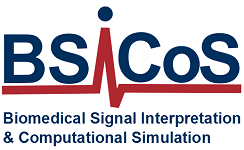-
Proyectos
Multimodal biomedical signal processing for the analysis and characterization of cardiovascular, respiratory and autonomic deseases
Fecha de inicio
2011
Fecha de finalización
2014
Coordinador
Juan Pablo Martínez
Funding agency
MICINN, TEC2010-21703-C03-02
This project investigates and evaluates new approaches to extracting, interpreting, integrating and modelling relevant clinical information derived from multimodal biomedical signals and invasive and non-invasive measurements to improve the knowledge of underlying physiological mechanisms in a relevant and highly prevalent number , cardiovascular, respiratory, autonomic nervous system diseases, as well as other non-pathological disorders (drowsiness, emotional disorders, microgravity, …).
The main objective of this project is to improve the interpretation and physiological characterization of such conditions through the use of advanced multimodal signal processing and modeling, to improve the early diagnosis of certain pathologies, more accuracy in the non-invasive risk stratification and the optimized planning of interventions, such as cardiac resynchronization therapies and ablation for atrial or ventricular arrhythmias.
The different proposals considered are aimed at a common goal: they are based on signal models based on establishing physiological knowledge in each condition studied. Many of the disorders addressed in this coordinated project have an effect on more than one biological system. For example, obstructive sleep apnea (OSAS) causes changes in the respiratory and autonomic nervous systems, and with subsequent cardiovascular effects. Sudden cardiac death is related to a combination of factors from the cardiovascular and autonomic nervous systems. This suggests that a multimodal integration proposal could improve the prognosis and diagnosis results obtained, considering only one type of signal.
Our hypothesis is that the joint analysis of bioelectrical, mechanical, sound and blood signals, information from images and the customization of “in silico” models will improve the knowledge of the physiological phenomenon and the diagnostic / prognostic capacity. The integration and fusion of biomedical data from different sources, in the same space-time coordinates, will allow the integration of multi-physical and multi-scale computational models and the design of advanced tools to improve the detection and assessment of pathologies.
This proposal is specified in signal processing methods used in various relevant applications within the following fields: • Detection and classification of sleep disorders. • Assessment of asthma and chronic obstructive pulmonary disease (COPD). • Characterization of the respiratory pattern in patients with chronic heart failure (CHF). • Location of epilepsy foci. • Risk assessment for sudden cardiac death and ventricular arrhythmias. • Early detection of myocardial damage (ischemia, Chagas, dilated cardiomyopathy). • Activity and integration of the autonomic nervous system, analyzing cardio-respiratory and pressure signals in non-stationary conditions. • Evaluation of the physiological-emotional state through the analysis of the variability of the heart rhythm (HRV). • Stratification of patients who would benefit from cardiac resynchronization therapy in patients with heart failure. • Physiological effects of prolonged microgravity. • Characterization of atrial and ventricular activation patterns in invasive electrograms aimed at ablation in atrial fibrillation and ventricular tachycardia.
